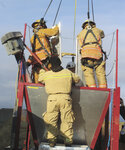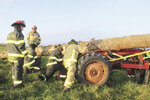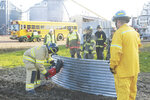


MARSHFIELD, Wis. — Until farm accidents stop happening, Pittsville Fire Chief Jerry Minor said he will continue to advocate for training emergency response personnel in how to deal with those situations without becoming part of the problem themselves.
“Farm accidents are very different from the typical things we deal with,” Minor said. “We don’t see them as frequently, so we aren’t as well versed in how to deal with those situations. That is why this training is so important.”
Minor works hand-in-hand with the National Farm Medicine Center and the Rural Firefighters Delivering Agriculture Safety and Health program to facilitate the Agricultural Rescue Training event, which is in its third year.
“There has really been a high turnover in the demographics of many rural fire departments,” Minor said. “There are a lot of younger people getting involved in the departments, so training them how to handle these issues is very important.”
Minor said the training does not only benefit those in attendance, but it is beneficial to the entire community, both agricultural and non-agricultural.
“When these incidents happen, they are usually traumatic to everyone because they are dangerous and not that frequent,” Minor said. “And unfortunately, they end too often as a fatality.”
Those factors make the ART program crucial to every community, Minor said.
The third annual ART was held Oct. 20-21, with a lecture series at the NFMC and an on-site training exercise held at nearby Heiman Holsteins, both in Marshfield. Included in the lecture series were presentations about working with agricultural chemicals and poisons on the farm, silo rescues and large animal technical rescues. There was also a demonstration of Farm MAPPER 2.0.
Participants had the opportunity to attend additional training to learn how to take the information they gained back to their departments to train their colleagues.
On the farm, emergency responders participated in hands-on learning simulations for tractor rollovers, silo rescues, grain bin rescues, equipment extrication and large animal technical rescues.
“There are so many scenarios that might create an incident on the farm, but we try to hit the ones we see the most,” Minor said.
The training does not vary much from year to year, but this year Minor said they did include a station dealing with working with large animals, taught by Dr. Howard Ketover and the Wisconsin Large Animal Emergency Response team.
“Last year we had a lecture by Dr. Ketover, and the feedback was really strong asking for hands-on training, so we added that for this year,” Minor said. “That station was really well received.”
Nearly 60 emergency responders from departments and units in Wisconsin, Minnesota, Missouri and Colorado took part in ART. In the past two years, 214 emergency responders from 89 departments have been trained through the program, including 17 who were trained to become instructors.
With the knowledge that most rural first responders are volunteers who give willingly of their time to not only respond, but to train for that response, departments with three or more personnel attending the training receive a free four-gas monitor.
The monitors are provided through the Mike Biadasz Farm Safety and Education Memorial Fund, which was established in memory of the central Wisconsin farmer who was fatally overcome by hydrogen sulfide gas while agitating a manure pit Aug. 15, 2016.
Prior to this year, 23 departments have been given the monitors, which are not only intended to keep the emergency response teams safe, but they can also be loaned to farmers to use as a measure of prevention to keep similar accidents from occurring.
While Minor said there are few repeat attendees, there are many departments that send personnel each year.
“That is really encouraging,” Minor said. “That means the guys who came one year go back and tell the others in their department that the training is worthwhile.”
Like the general population, most emergency response personnel have little or no experience being on the farm.
“That lack of background means these trainings are paramount for ensuring safety of the responders and improving the odds for a successful rescue for the victim,” Minor said. “As long as there are farm accidents happening, we will keep training to help responders be proficient in their response.”
Comments
No comments on this item Please log in to comment by clicking here